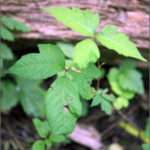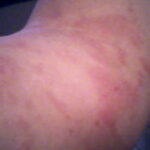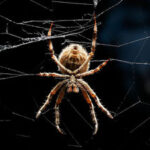If you have ever suffered from a case of poison ivy then you know you do not have to ask the question, “Is this rash poison ivy?” The most memorable symptom of a poison ivy rash is the itch. It is an itch unlike anything you have ever imagined. Mosquito bites, dry skin and healing wounds are all very itchy in their own right, but nothing compares to the itch of poison ivy. It is constant, severe and unrelenting and unfortunately, the more you scratch the more irritated and itchy the rash becomes.
At first it may be mistaken for a mosquito or other insect bite but within 48 hours what you thought was one insect bite turns into a red angry rash with an elephant sized itch. Urushiol is the culprit and it is found on the leaves of the poison ivy plant, whether the plant is dead or alive. If it comes in contact with your skin it must be washed off within a few minutes to prevent the poison ivy rash from developing.
The poison ivy rash is characterized by raised red bumps which, in my case, most often fill with fluid, causing it to look like blisters. According to the many sources of information I have read about poison ivy over the years, the only way to contract the poison ivy rash is to come in contact with the urushiol oil from the leaves of the poison ivy plant. You cannot get a poison ivy rash from someone else’s rash.
But you can come into contact with urushiol without touching the leaves of the poison ivy plant. Since it takes 24 to 48 hours after contact for the symptoms of the rash to appear it is very likely that you will spread the urishiol to many different places without realizing it. Urishiol will adhere to anything and remain there until it is washed off with some kind of soap and water, including your skin. It takes the very tiniest bit of urishiol to cause the allergic reaction of the poison ivy rash.
Maybe you went for a walk in the woods and just happened to step on some poison ivy. You return home and take off your shoes, transferring the urishiol to your hands. You scratch at an itch on your forearm transferring the oil there also. You sit down on the couch and your arm touches the armrest and the couch pillows. You lie down in bed, touching the sheets, blankets and pillow…and so on.
Two days later you notice a little mosquito bite that itches really bad. The day after that you have a full blown case of poison ivy rash. How many surfaces did you touch and transfer the urishiol oil onto? Since urishiol will adhere to and stay on any surface or material until it is washed off with soap and water it’s very important to wash everything you may have touched. Use soap or some sort of detergent because urishiol is not water soluble so water alone will not do the job.
My family likes to go hiking so I always make everyone take a cool shower with lots of soap after we’ve been in the woods. Then I throw everything we had on our bodies into the washer, including our shoes. My mom always swore by Fels Naptha soap (a heavy duty laundry bar soap) to wash our skin if we had a poison ivy rash. Now I use it as well, to treat the poison ivy rash and also to prevent it.
Obviously the best way to prevent poison ivy is to stay away from the plant itself. But if you live in the eastern United States where poison ivy is the most prevelant and you love the outdoors, then chances are you will have to deal with a case of poison ivy at some point in your life. As far as I know, no one has ever died from a case of poison ivy. And yes, I have had such severe cases over a large part of my body for weeks at a time that I was actually concerned about that prospect!
If you are unfortunate enough to develop this maddeningly irritating, itchy rash, I’m sorry to say there is no cure or quick fix. Most cases last about two weeks but can last up to five weeks and it must run it’s course. All you can do is relieve the symptoms, sort of like the common cold. The most important thing is to eliminate any traces of the urishiol oil. The only reason the rash spreads is because you still have the oil on your skin, underneath your fingernails or on some other material that is coming into contact with your skin.
It’s important to keep the rash clean and dry. There are all kinds of products out there promising to clear up the poison ivy symptoms within a couple of days. I read an article on Wikipedia that showed test study results using expensive remedies versus plain old soap with very little difference. As with other things, you may have to try different things before you find what works best for you.
I have been exposed so many times that now my reaction is very severe. More often than not, I seek medical attention for a prescription of prednisone (topical cream or oral medication) to ease my symptoms and speed my recovery. The allergic reaction to the rash becomes stronger after repeated exposure.
Hydrocortizone creams and oral antihistamines can also be helpful for relieving the symptoms. It’s also very important to keep yourself from scratching, and it’s extremely difficult too, I might add. Cool showers help and I’ve also used ice packs pressed on the rash to relieve the itch. If you scratch the rash it becomes more irritated and inflamed. You can also cause a secondary infection that could require antibiotics.
If you’ve never had a poison ivy rash then consider yourself lucky, but if you have, you know you would do almost anything to stop the almost unbearable itching and discomfort. Just be aware of where the poison ivy grows and try to avoid any contact with your bare skin. If you have been exposed, wash the affected area as quickly as possible with cool water and soap and hope for the best.
Sources are links in this article.





